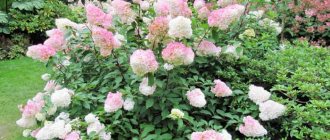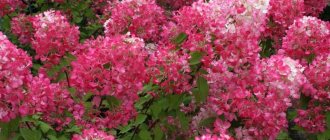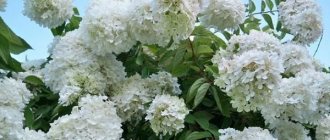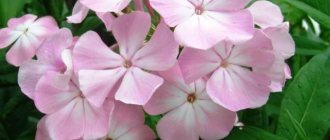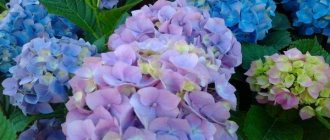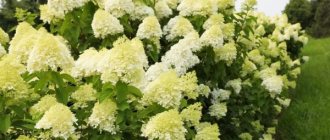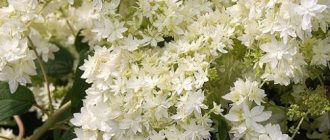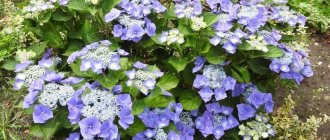Many gardeners have been growing white hydrangea for quite a long time. White hydrangea is considered a real decoration of the garden. The caps of these flowers are simply beautiful; they fascinate with their stunning appearance and unsurpassed aroma. That is why gardeners have been growing white hydrangea in their garden plots for a long time. In today’s article we will tell you about the origins of this crop, share with you a description of the variety, the secrets of propagation, planting and care rules, and at the end we will tell you how to properly prepare plants for winter and fight diseases.
About the history of the variety
White hydrangea: photo
Initially, hydrangea had only two colors: red and white, but sometimes gardeners say that there were pink and blue varieties. Breeders in many countries have worked hard to develop these varieties, so these large-leaved plants currently have a wide variety of species; the origin of the name of the crop is interesting. Currently there is more than one version.
The most famous is associated with the name of a flower in honor of a certain princess; she was so pretty that her brother named this beautiful flower after her. According to another version, hydrangea received such a beautiful name at the behest of a French doctor, namely in honor of his beautiful beloved. There is a more scientific explanation for such an interesting name for the culture. Since this plant is considered to be moisture-loving, it is also called hydrangia, which means a vessel with water. This culture is also called the purple sun; it is believed that the plant’s natural habitat is India, Japan, and America.
Advantages of hydrangea
The best garden decoration, according to gardeners, has the following advantages:
- a wide variety of species and varieties, which allows the most picky gardener to choose a shrub;
- you can create a hedge from picturesque shrubs;
- rarely gets sick and is not afraid of pests;
- long and lush flowering;
- Arrangements made from dried flowers look beautiful;
- A sweet drink made from hydrangea (amacha) has magical properties. Therefore, Buddhists classify it as ritual;
- leaves and roots have medicinal properties.
There is one drawback - some types of this beautiful bush are not frost-resistant and cannot delight Russians with their flowering.
Varieties of hydrangeas
Hydrangea is very popular among gardeners; most of all, gardeners fell in love with tree and paniculate hydrangea. The first has huge snow-white spherical inflorescences, as well as very large leaves, so it crushes the tree, but paniculate hydrangea forms inflorescences shaped like panicles, but its leaves are slightly smaller. That is why these varieties received such names. Currently, the following varieties of hydrangea varieties are very popular: Anabel, white house, sterilis, hi star best and others. But most gardeners love to grow white hydrangea, since this crop is very unpretentious, its leaves are always large, so this plant perfectly decorates any garden. Hydrangea is often planted near houses and administrative buildings. The white lady variety is interesting, as is Grandiflora. In fact, there are a lot of varieties of white hydrangea, so you are sure to find something that suits your taste.
Other types of hydrangea
Green rose - varietal variety, what are there
In total, the hydrangea genus has more than 50 species. In Russia, the shrub grows naturally on the Sakhalin Peninsula and the Kuril Islands.
Hydrangea Bretschneider
Bretschneider's hydrangea (Hydrangea bretschneideri) has a high level of winter hardiness. The plant was discovered by a botanist in 1882 in the mountains of China. The species is not widespread due to its unpretentiousness of its inflorescences and lacks varietal diversity.
Flowering occurs in the second half of summer. The inflorescences are corymbose, flattened, consist mostly of small white fertile flowers, only a few sterile, large ones are located along the edge of the cluster. The bushes are very tall, about 3 m, and can compete with the widespread thuja.
Hydrangea petiolate
The shrub is a liana-like plant; with the help of suckers and aerial roots growing on the trunk, it can wrap around supports up to 20 m high. Without supports, petiole hydrangea behaves like a ground cover plant.
Liana petiolate
In its natural habitat, the liana lives among coniferous forests, entwining powerful tree trunks. Petiolate hydrangea spread from eastern Asia (Sakhalin Peninsula, Kuril Islands, Japan, Korea, China).
Other types of garden hydrangeas are not very common.
White hydrangea: description of varieties
White hydrangea: photo
It is believed that the birthplace of the globular white hydrangea is the United States of America. That is why the culture is considered very winter-hardy, so these plants can be grown in temperate latitudes, as well as in Siberia and the Far East. However, in severe winters the bushes sometimes freeze, so the plants should be covered. Shrubs of spherical white hydrangea are usually low, up to 2.5 m in height. The leaves are large, oval in shape, slightly ovoid, with a noticeable notch in the core and jagged edges. Leaves grow on drooping shoots, the leaves are bright green at the top, but bluish underneath.
The crown of the shrubs is also spreading and round in shape. Hydrangea inflorescences are also quite large, 25 cm long. Usually flowers form at the tips of annual shoots. Moreover, they are located on the plant very chaotically, usually at first the flowers are soft green, and then they become white, creamy, and milky. The seeds are collected in boxes, oblong and small in shape. White hydrangea begins to bloom in mid-summer and blooms very profusely, so before frost you can please yourself with the pleasant color of the inflorescences and aroma.
Other popular types of garden hydrangeas
Rose Laguna - what kind of variety, what types are there?
In total, there are approximately 80 varieties of royal flowers that came from Southeast Asia and North America. All types of hydrangeas have their own characteristics and unique characteristics.
Hydrangea purple
Hopcorn Blue has a purple or bright lilac color. Grows in well-lit areas, the variety is frost-resistant. The height of the bush reaches 1 m. The flowering period is July-September.
The Ramars variety is characterized by flowers of different colors - purple, blue, light blue and violet. Loves shade, moisture and reaches 80 cm in height.
Hydrangea yellow
The yellow Lamlight variety is very popular. Flowers appear on the plant from mid-summer to September. They change color from greenish yellow to creamy yellow.
The characteristics of the species are fully revealed when planted in partial shade. To obtain yellow flowers with green accents, it is necessary to remove the hydrangea from direct sunlight.
Hydrangea burgundy
Weems Red is a beautiful bush up to 2 in height with large openwork flowers covering it from the top to the ground. The flowering period begins in early summer, when white buds appear, but later they become deep pink and then acquire a burgundy-red color.
Hydrangea lilac
The Thinker's Dream is characterized by large flowers up to 3 cm in diameter, which are collected in an inflorescence with a diameter of up to 20 cm. The original color of the variety is lilac, but new forms can be with the addition of pink or white shades. The shrub blooms in July, but the flowers do not completely fall off.
Blue hydrangea in the garden
Hydrangea white-pink
The delicious variety Vanilla Fraze is often compared to strawberry ice cream and cream. Shrub up to 2 m high, with heavy inflorescences and small white-pink flowers. It rarely gets sick and is used to create hedges. Flowering period – June-September.
Royal hydrangea
The bush variety Royal Flower is distinguished by its stable and durable inflorescences. The plant grows up to 1 m in height with a diameter of 75 cm. At first the flowers are white, but by the end of the season they take on a soft pink hue. The flowering period occurs in mid-summer to early autumn. Loves partial shade, drained and moist soil.
Hydrangea tricolor
Holiday is a plant variety that produces tricolor flowers with bright pink petals, a bluish center and light green tips. Lush shrubs grow up to 1.2 m in width and height. It is also worth paying attention to Tricolor; this hydrangea is characterized by an unusual foliage color. A low-growing bush, used for group or single planting, has tricolor leaves.
Interesting! The shrub is called Ajisai in Japan, which means “sunny purple flower.”
Low-growing hydrangeas for the garden
Most often, the plant grows up to 3 m with spherical or flat inflorescences measuring about 20 cm. There are varieties that are intended for growing in small containers and pots. Low-growing varieties grow up to 1 m in height and here are the most popular of them:
- Bomshel;
- Pinky Winky;
- Bobo;
- Brussels Leys;
- Darts Little Dot;
- Last Post.
Large-leaved hydrangea does not tolerate cold or limestone. It grows up to 50 cm in height, and the flowering period occurs in mid-summer. The most popular varieties are Peremenchivaya and Japanese.
Hydrangeas with small flowers
The Japanese Bluebird variety is a bush with a strong trunk up to 1 m 20 cm high. The crown can grow up to 1.5 m wide. Oval green leaves with jagged edges. Serrated hydrangea has small purple or pink flowers on the inside and larger blue-tinged flowers on the outside.
Hydrangea largeleaf
Chameleon is a variety of ornamental shrub with inflorescences up to 17 cm in size. Erect shoots reach 1.5 cm. Large-leaved hydrangea has small pink flowers and bright green foliage. The color range varies from red to blue depending on the acidity of the soil.
Unique Chameleon on the street
An equally popular large-leaved variety is Castle Wackenbart. The height of the bush reaches 1.2 m, which has large spherical inflorescences and blooms from July to October. The petals are pink with a smooth transition to a blue center, which undoubtedly looks beautiful in a bouquet. The color of the leaves is affected by the acidity of the soil. Used in landscape design.
Interesting! Hydrangea is one of the plants that accumulates aluminum. When absorbing an element from the ground, some species acquire a bluish tint.
Regardless of whether it is a regular white hydrangea or a globular pink hydrangea, it remains the queen of the garden. A huge number of species and varieties allows you to combine several plants, create a hedge or control their flowering periods. Depending on the variety, the planting will have a certain color scheme, height and crown diameter. Before purchasing seedlings, you need to understand what types of hydrangeas there are and how to properly care for them.
White hydrangea: propagation
White hydrangea, like many other crops, reproduces in different ways. Namely by cuttings , by dividing the bush , by layering and by sowing seeds . If you decide to plant seeds, then this must be done at the end of winter. Hydrangea is grown through seedlings. The seeds are planted in loose and nutritious soil, the first sprouts appear in about a month and a half. When the plants are formed, they will need to be planted in separate containers. In spring, the crop is planted outside.
Many people are engaged in cuttings, for this you will need to cut the cuttings in time. In order for the root system to form more intensively, the shoots will need to be treated with rootstock, and only then planted in different containers. To take cuttings, you should choose lignified branches. Typically, cuttings take root a month after planting. If you decide to replant white hydrangea, then you can divide the bush, usually this is done in the spring, cutting the root systems into two or more parts.
Layers also take root well. In order to propagate a plant using this method, you will need to bend a young branch, preferably an annual one, to the ground and sprinkle it with nutritious soil. Do not forget to water the cuttings; when the shoots take root normally, they can be separated from the main bush, usually this is done the next year.
White hydrangea in landscape design
White hydrangea is used very often to decorate the garden; it looks extremely impressive against the backdrop of summer greenery. The shrub is used for:
- creating hedges and dividing the garden into separate zones;
- formation of group and single decorative compositions;
- decorating empty areas of the garden, for example, the space near the wall of the house;
- artistic design of fences and hedges.
White hydrangea goes well with tall trees, other shrubs and perennials. The bush can act as the basis of the composition when creating mixborders.
A flowering hedge looks especially impressive
White hydrangea is especially valued for the fact that it retains its decorative effect, including in early autumn. Most shrubs and perennials have already finished flowering by this time, but hydrangea still pleases the eye with its snow-white inflorescences.
White hydrangea: planting
White hydrangea: photo
White hydrangea loves slightly acidic, loose and fertile soil. But it is not advisable to plant hydrangea in sandy and acidified areas. There it will grow poorly. And you should not lime the soil either, since this crop does not like wood ash. It is advisable to plant hydrangea in an area well lit by the sun and also protected from the wind. It is best to plant this crop near any buildings so that cold air does not interfere with the development of the plant. If you have a lot of free space on your site, then plant hydrangea on the east side. There it will grow intensively. In order for hydrangea to grow normally, leave two meters between plantings. Usually this crop is planted in open ground at the end of spring, in May, when the ground has warmed up considerably and the frosts have finally subsided.
Over the summer, white hydrangea has time to take root well, which means it will overwinter normally. In southern latitudes, this crop is sometimes planted in the fall, where hydrangea also grows well at this time. The planting pit will also need to be prepared in advance, about a month before the planned date of the hydrangea exhibition in open ground. It should be approximately 50 cm deep and up to half a meter wide. However, you should consider the size of the seedlings' root system. Therefore, the dimensions of the pit may also vary. Gardeners often recommend taking soil from under coniferous trees; hydrangea grows beautifully on it. Before planting a shrub, it is recommended to shorten all annual shoots by several buds. The seedling is placed in the center, the root system is well straightened and only after that the holes are filled with a fertile mixture. Don't forget to compact the soil surface and water the plants generously. For this you will need at least one bucket of water.
Sometimes gardeners immediately mulch the top layer of soil, and for this they use sawdust, dry grass, and tree bark. This helps retain moisture and get rid of weeds. If you want the seedlings to start blooming early, then they should be planted closer to each other, eighty cm apart, but after two years the plantings should be thinned out. The root collars cannot be buried; they must rise above the surface of the earth.
How to distinguish the paniculate species from others?
In the open ground of the middle zone and Siberia, in most cases, tree-like, large-leaved and paniculata hydrangeas are cultivated. Although there are serrated, petiolate and other types on sale. Each one is suitable for the Moscow region, but some can only winter with shelter. At the same time, you can purchase tree varieties of peonies to accompany them; there are many options for the Moscow region and Siberia.
The paniculate representative can be distinguished by several characteristics:
- The inflorescences are panicle-shaped and consist of many small flowers of two types. The first type is beautiful and sterile, the second is inconspicuous, fruit-bearing. The size of panicle inflorescences can reach 25 cm in length and even more. The density and structure of different varieties differ. The more sterile flowers, the denser and more voluminous the panicle.
- The color of the petals of some representatives changes over the seasons from white in spring to pink in summer and gray-green or cherry in autumn.
Vanilla Fraze on the lawn - This species withstands frosts, as by autumn the shoots are covered with bark. Adult plants in the Moscow region successfully winter without shelter at temperatures down to -25°C. Only young plantings and some capricious varieties need insulation.
- It blooms on the shoots of the current year, so a little freezing is not so bad.
- It develops quickly, growing by 25-30 cm per year. It grows in one place for up to 60 years.
- Most varieties fill the air around with a pleasant aroma.
If paniculate hydrangea is chosen for planting, it is better to get acquainted with the description, characteristics and varietal characteristics in advance, so that there are no problems with care later. Depending on the method of formation, hydrangea is grown as a bush with several trunks or as a standard tree. If the seedling is not pruned, it can reach a height of 5-8 m. Usually, lush bushes up to 1.5-2 m grow on the site, but subject to the use of fertilizers. Feeding honeysuckle or grapes is more difficult to organize, but problems arise with hydrangeas in rare cases.
White hydrangea: care
As you understand, white hydrangea is considered moisture-loving, so it is necessary to moisten the soil quite often. Every week, up to twenty liters of water are carried into the soil. It is best to use rain moisture for this. If there is excess rainfall in your region, then the crop should be watered 4-5 times during the summer. If the soil dries out, this will not have a favorable effect on the development of hydrangea. Therefore, in such conditions, the crop develops worse, and winter hardiness decreases.
To prevent plants from getting sick, experienced gardeners add a little potassium permanganate to the water for irrigation. It is best to irrigate the soil either early in the morning or late in the evening. And in order to better preserve moisture, the soil is mulched. If the autumn is also quite dry, then the crop should be watered at this time. And do not forget to loosen the soil after watering so that an earthen crust does not form.
Usually it is not recommended to feed seedlings for 2 years, but at the age of three it is recommended to add microelements to the soil; complex mineral fertilizers are suitable for this. When buds begin to form on the plant for the first time, the hydrangea should be fed with superphosphate. And at the end of summer, add a little potassium sulfate to the soil. Gardeners often water the bushes with liquid mullein, as well as chicken droppings, previously diluted in water. Sometimes the soil is fed with lactic acid. However, it is undesirable to overfeed this crop, since excess nitrogen in the soil negatively affects plant development. It is strictly forbidden to introduce wood ash into the soil.
Don't forget about pruning plants. It is better to remove unnecessary shoots in early spring, before sap begins to flow. To make shrubs bloom more abundantly, you will need to remove small buds from the bush in the first years and thin out the remaining shoots. In early spring, it is recommended to carry out sanitary pruning; sometimes old shrubs are rejuvenated by removing all diseased, old and dried branches. Shorten the shoots by about 5 buds. By radically rejuvenating the shrub, gardeners cut off all the shoots at the roots; young shoots will begin to grow in the next season.
Agrotechnical features and care rules
Flowering occurs due to sterile flowers that are not capable of producing seeds
You can grow hydrangeas according to the traditional method , but special attention should be paid to transplanting, watering and pruning.
Location, lighting, temperature
The optimal air temperature during plant growth is +18-+23C
Light shading is more suitable for the “gentle beauty ,” so she feels most comfortable in the garden, under the canopy of trees. In sunny, open spaces, the leaves quickly wither and the plant loses its decorative effect. Hydrangea does not like drafts, so choose a suitable corner, closed from the winds.
In indoor culture, a pot with a flower is placed on the eastern, and in winter - on the western windowsill. In the summer, they are taken out onto the loggia, balcony or terrace. If the place is sunny, then the hydrangea is slightly shaded. The plant is light-loving, but too bright light from southern latitudes is not the best option for it. In Russian gardens, hydrangeas do not have to be left in partial shade, because there are not so many truly sunny days in the summer.
The flower does not need a too hot atmosphere: a cool summer is the most suitable option for it. It is recommended to maintain the temperature range within +18-+23C. If the specimen is indoors, then in autumn and winter the temperature is reduced to +5-+10C, gradually increasing it in the summer. Most varieties of hydrangea grow in southern gardens, as they are not cold-resistant and are not able to survive the winter in harsh Siberian winters.
Watering and air humidity
Hydrangea or “water vessel” cannot live without constant water supply
Moisture for hydrangea is literally “life-giving”. The soil in the tree trunk circle is constantly moistened, trying not to flood it. A dry earthen lump is an unacceptable phenomenon.
Basic rules of watering:
- carry out once every 1-2 days for small plants and once every 7 days for bushes;
- use settled water (preferably rainwater);
- in indoor culture, place a tray with wet pebbles under the plant;
- spray periodically, trying to prevent drops of moisture from falling on the inflorescences
- In autumn, the amount of watering is reduced.
Pay close attention to soil moisture. Hydrangeas bloom only with optimal watering. After watering, the tree trunk circle is covered with mulch so that moisture from the soil surface evaporates more slowly.
Soil and fertilizing
Granules with nutrients are embedded in the soil and watered abundantly.
Hydrangea does not make any special demands on the soil. It grows well in areas to which turf soil, sand and peat substrate are added. To make the plant feel 100% comfortable, use a mixture of sand, humus or compost and peat (1:2:1).
The flower prefers acidic soil (pH = 5.5) and if the soil composition is neutral, then an acidifier is added. Universal preparations include garden sulfur, which acidifies the earthen substrate efficiently and for a long time.
Why does hydrangea change the color of its inflorescences? The color scheme depends on the pH value. Cream flowers will bloom on neutral soil; lilac or pink specimens will appear on alkaline soil. The acidic environment gives rise to spectacular blue and blue inflorescences.
It is easy to acidify the soil by adding aluminum sulfate or potassium alum to get blue shades of flowers. Initially, the color of the inflorescence is white and gradually it changes its colorful palette, based on soil conditions.
To guarantee a blue tint to the inflorescences, on the eve of flowering the plant is watered with a solution of aluminum alum, diluting 5 g in 1 liter of water.
Double superphosphate as a top dressing
Weed control is carried out throughout the growing season . This simple rule of agricultural technology is also relevant for hydrangea. After this, loosening is carried out to a depth of 5-6 cm, since breathability and light soil are important factors for the full development of a capricious plant.
Fertilization for hydrangea is carried out in stages:
- At the beginning of growth, it is preferable to introduce a complex mineral composition with microelements. It is advisable to feed with urea (according to the instructions) or slurry (diluted 1:10) so that the hydrangea quickly forms strong, green shoots.
- The second feeding is carried out on the eve of flowering. During this period, superphosphate containing phosphorus and potassium sulfide are added under the plant. This is necessary for the development of inflorescences.
- During the summer, you should fertilize in a timely manner with organic compounds (herbal infusion or mullein infusion). Ash is not used, as it deoxidizes the soil.
Fertilizing is carried out once every 2 weeks, treating an area of 1-1.5 m around the plant. An adult bush requires up to 10 liters of solution. Granular fertilizer is worked around the bush and then watered generously to avoid burning the roots with the concentrated nutrients.
By mid-August, feeding stops . During this same period, watering begins to be reduced.
Hydrangea does not like excessive amounts of fertilizing: fertilization should be moderate. This especially applies to fertilizers with nitrogen, thanks to which the bush grows profusely, but does not bloom.
Planting and transplanting
hydrangea hedge when planted correctly
Hydrangea planting and subsequent care are carried out on spring days, until the buds swell. This procedure is also possible in the fall, if there are no frosty winters in the region and the root system of the plant is well developed. On the eve of planting, the roots are slightly shortened and annual shoots are removed.
If the bushes are planted singly, then prepare a planting hole 35-40 cm deep and 50-70 cm wide. The ratio of the diameter of the hole and the crown of the grown bush (based on the specific variety) should be the same. When planting a hedge, the scheme is somewhat different: they dig a strip up to a meter wide, keeping a distance between bushes of 1.5-2.5 m (depending on the varietal characteristics).
Hydrangea seedlings are planted in soil with a fertile composition:
- humus (2 parts);
- peat and sand (1 part each);
- superphosphate matchbox;
- 1 tbsp. l. urea.
It is mixed and then the hole is filled. There are enough nutrients so that you don’t have to think about feeding for 2 years.
Superphosphate is added to the planting hole, evenly mixing with the soil.
Planting algorithm:
- Pour a mound of “cultivated” earthen mixture into the planting hole
- Remove the seedling from the ground, free the roots and carefully place them on the surface of the created mound.
- Carefully water the resulting “hut”
- Fill with the remaining nutrient substrate up to the root collar
- Compact the soil so that there are no voids left inside, and water again
- Mulch the tree trunk with sawdust, peat or pine needles
A layer of mulch of about 10 cm will help retain moisture, support beneficial microflora and prevent the root system from being exposed. During the summer, the surface layer is loosened 2-3 times, and mulching material is added in spring and autumn. Seedlings bloom after 4-5 years of growth.
If the site was initially chosen poorly, then you can move the hydrangea to a new place at 5-6 years of age , when the perennial shoots become lignified. This is a difficult undertaking for a person, since the root system is large, the bush is well rooted and strong.
This is a stressful event for the plant itself: it is difficult for it to take root at this age. It’s easier to think through the layout in advance, taking into account the plant’s requirements for conditions.
Mulch is not only useful, but also decoration
Hydrangea roots are not able to penetrate deep into the soil. This must be taken into account when planting in combination with other plants. There should be no garden crops with a shallow root system nearby, as they will begin to fight for moisture and nutrients. This exhausts the bush and weakens flowering.
Trimming
Autumn, anti-aging pruning promotes the growth of young shoots
Caring for and growing hydrangeas includes a pruning procedure. It is carried out according to the rules that should be taken into account:
- Begins in early spring before the start of sap flow and swelling of the buds. From 6 to 12 of last year's strongest shoots are left on the bush, shortening the tops by 2-5 buds.
- Flower clusters are formed on the apical shoots of the current year of life. The more flower buds are laid, the more inflorescences there will be, but their flowers will be small.
- Once every 2-3 years, rejuvenating pruning is carried out, removing old branches that are not capable of forming young shoots. At the same time, thickened and broken branches are removed.
- During growth, faded clusters should be removed to stimulate the growth of new inflorescences.
- In the fall, it is worth carrying out severe pruning for rejuvenation, cutting off last year's shoots into stumps of 5-8 cm. Next year they will give rise to new shoots. This procedure is carried out once every 5 years.
Hydrangea is painful to pruning, so after it is done, the plant is fed and its condition is monitored. When the bush fades, faded, dried inflorescences should be removed. They are cut off with the shoot, shortening it by 2-4 buds. Inflorescences should be trimmed in the fall before the onset of cold weather.
Each variety of hydrangea requires a special approach to pruning.
Don't be too zealous and do deep pruning regularly. With this approach, there will be no inflorescences at all. There is no “gentle” pruning for annual seedlings.
White hydrangea: preparation for wintering
White hydrangea: photo
Typically, plants begin to be prepared for wintering in September. Faded inflorescences will definitely need to be removed and the branches bent low to the ground. To make it more convenient for you, they can be tied. This is done so that the shoots do not break under the weight of the snow. It is recommended to cover seedlings that are too young. To do this, the root zone is covered with fallen leaves. In general, this crop is considered winter-hardy, so these plants are grown even in Siberia and the Far East. However, there it is necessary to cover the plants with fallen leaves and agricultural material. Bushes are usually covered with burlap and spruce branches. Before frost arrives, the tree trunk circle is covered with peat or compost.
After this, the shoots are pulled together and covered with some kind of breathable material. However, it is not recommended to use film for this, since moisture accumulates under it and the shoots begin to rot. In March, the shelter is removed and the mulch is also swept away, but if the frosts have not yet completely receded, then you need to wait until at least April. If certain varieties of hydrangea are not winter-hardy, they are recommended to be replanted in boxes. In this case, you will need to remove all the leaves from the bushes, and then transfer the plants to the basement.
Variety selection
Among the variety of varieties of hydrangea, it is sometimes difficult to make a choice - the range presented is so wide and varied.
For public places
Pay attention to the size of the bush . Often, fascinated by the color and splendor of the inflorescences, gardeners reveal the final size of an adult plant.
For the limited space of a summer cottage, large hydrangeas with a height above 2 meters may be redundant . However, for parks or decorative city flower beds such plants will come in handy.
For planting near the porch and along paths
For decorating the local area, porch area or garden paths, dwarf varieties are suitable, whose adult height will not exceed 1 meter .
Ombre varieties
The unique ombre coloring with a soft color transition creates an incredible picture. Such plants will easily become the center of a decorative composition or create a soft romantic atmosphere when planted next to the gazebo.
Winter-hardy and cold-hardy hydrangeas
It should be noted that paniculate hydrangea itself tolerates harsh winters well .
Many varieties need shelter only in the first 2–3 years after planting in the ground, after which it is quite enough to mulch the tree trunk generously.
Among the winter-hardy varieties there are:
- Limelight;
- vanilla fraise;
- bobo;
- Levana.
White hydrangea: diseases and pests
White hydrangea has good immunity, however, when planting the crop in the wrong soil, insect pests may appear on the site. If hydrangea gets chlorosis, this indicates an excess of lime in the soil. Therefore, you should spray the foliage with copper sulfate. Sometimes this crop suffers from powdery mildew. This is due to the fact that the surrounding air is very humid, so the plants also need to be sprayed with copper sulfate, and in order for the preparations to better adhere to the surface of the foliage, they should be treated with a soap solution. Sometimes green aphids settle on hydrangea leaves. These pests do not like garlic, so this plant can help you fight these harmful insects. Spray the foliage with garlic tincture every day for a week, after which the pests usually leave the area.
The best new panicle hydrangea varieties for 2022
Breeders regularly develop new varieties of flowers. Among the best new panicle hydrangeas of 2022, several varieties can be distinguished.
Pinklight
Pinklight - bush up to 1 m tall. Plays with bright colors throughout the season. The palette is varied, mainly lemon and hot pink. It has good frost resistance.
The Pinklight variety is taking root in different regions of Russia
B.G.
Flower with greenish tints. For now, its name is encrypted at the request of the copyright holder. However, it is known that it was developed in the Netherlands, and at the moment it is difficult to find even in European countries. But it will soon go on sale.
BG - a new product with greenish, lush inflorescences
Samara Lydia
Samara Lydia is a French variety. It is a compact shrub. It reaches 1 m in diameter and height. The buds bloom from July to early autumn. Cone-shaped inflorescences, bright palette.
Thanks to their bright colors, the flowers of Samara Lydia are visible from anywhere in the garden
Features of care during the flowering period
In order for the plant to develop correctly and undergo all vegetative cycles on time, a set of different measures is necessary. Here are the main ones:
- Regular moistening with settled or rain water - 25-30 liters per week; in hot weather, you can water it more often.
- Mulching, loosening and weeding the circle near the rhizome - three times during the summer.
- In the spring, use bait with nitrogen, and during the period when it begins to bloom - fertilizer with potassium, once every 14 days.
- Annual cutting of branches to rejuvenate and shape the plant.
- The best soil is a mixture of peat, sand and turf in equal proportions.
In preparation for the rest period, it is necessary to remove the foliage, tie the hydrangea in a bunch, do hilling, and install supports.
Attention! To prevent large inflorescences from breaking the stems, it is recommended to use support fences around the bush.
Frost resistance
In open ground in the garden, paniculate and tree-like types of hydrangea are most often grown. Despite the fact that they are considered cold-resistant, young plants require shelter during the frost period. Over time, the shrubs become more resistant to winter, and after the 4th year of existence they no longer need to be covered.
Regular pruning of branches
Plant species
Today in the world of gardening there are many types of hydrangeas. The most common among them is the large-leaved variety - this plant is not picky, but is unable to tolerate severe frosts. Its flowers can be painted in various colors, which the plant displays in the summer. The height of an adult shrub of this variety reaches two meters.
No less popular is the petiole hydrangea. This plant resembles a vine in its appearance, which is why it is often used to decorate arches and garden structures. It is appropriate to plant it near high supports, otherwise the plant will spread along the ground. The inflorescences of this garden hydrangea have a delicate white and pink color, which attracts the attention of many lovers.
Another common type of hydrangea is the tree hydrangea. The bush of this plant can reach up to 3 meters in height, thanks to which it looks very impressive during the flowering period. White garden hydrangea, as plant fans often call it, has large flower stalks that resemble huge hats. This variety is especially easy to care for. Moreover, this is a frost-resistant garden hydrangea; preparation for winter of this shrub is carried out without any problems.
Another common type of hydrangea is paniculata. This plant pleases the eye with its unique inflorescences, presented in the form of both small and large panicles, the length of which can sometimes reach 30 cm. These varieties are distinguished by their frost resistance and ease of care. As for the variety of shades, the color of the inflorescences can vary from snow-white to greenish.
About pests
The main danger to any outdoor hydrangea is leaf aphids. In more rare cases, false spider mites settle on shrubs, and this plant can also become infected with chlorosis and powdery mildew.
As practice shows, pests appear on shrubs due to the fact that the soil where they grow contains lime. In order to eliminate the problem, once every three days the plant needs to be watered with solutions containing potassium nitrate.
As for aphids, you can get rid of this pest by treating the plant with garlic infusion. In order to prepare it, you need to take a bucket of water and pour 200 g of crushed garlic into it. The mixture should be allowed to brew for a couple of days, and then the bush should be irrigated little by little until the pest is exterminated.
Species diversity
There are many varieties of this plant in the world, most of which grow in Japan and China. Fluffy spherical or paniculate inflorescences are most often white, but there are varieties with a wider color spectrum. Hydrangea bigleaf impresses with a range of colors from cream and pink shades to red.
The color is significantly affected by the pH value. In alkaline soil, hydrangea blooms with impressive pink or lilac colors. A neutral pH promotes the appearance of white or cream flowers. In acidic soil, blue and blue hydrangeas appear. By changing the acidity of the soil, you can get the desired shade.
Below are the main species and their varieties with photos and names, which are most common in gardens and impress with an incredible kaleidoscope of colors.
Hydrangea care
- Fertilizing with mineral fertilizers (it is necessary to fertilize in moderation, since voluminous inflorescences can break or bend the branches of the bush).
- Organic fertilizers: slurry, humus.
- Watering. The acidity of water for irrigation is recommended to be no higher than 5.6 pH. Hydrangea is very moisture-loving; it should not be overdried.
- Loosening the soil: from 3 times per season to a depth of 5-10 cm.
Hydrangea care
Trimming
- The bushes are pruned in the spring, when the buds have swelled.
- For successful wintering, young shoots are pruned to 4 buds.
- Old bushes are renewed by pruning at the root.
- With targeted formative pruning of cuttings over 4-5 years, you can get a beautiful small hydrangea tree.
- In the first year of flowering cuttings, the flowers should be removed, this will help the plant gain strength and bloom profusely next year.
More details about the intricacies of pruning various types of hydrangea are described in the publications:
- Pruning hydrangea
- How to prune paniculata hydrangea
- The many faces of panicle hydrangea (Hydrangea paniculata) and an alternative view of formative “classic” pruning. Part 1
- The many faces of panicle hydrangea (Hydrangea paniculata) and an alternative view of formative “classic” pruning. Part 2
Changing the color of hydrangea flowers
Large-leaved and new varieties of hydrangeas may change flower color. (except white or red). To do this, use various dyes sold in fertilizer departments.
- If you want to get blue shades, then use aluminum or iron crystals or aluminum sulfate (1 tablespoon per 5 liters of water) when watering 2 times a week.
- For pink coloring, use a solution of potassium permanganate.
- Peat can also affect the color change of hydrangeas. To do this, you need to water the plant with peat infusion; besides, it is also a good fertilizer.
Special additives will help change the color of hydrangea inflorescences
Shelter for the winter
When covering a hydrangea horizontally for the winter, you preserve the flower buds that form on the branches of the plant (in species that bloom on last year's shoots). Then the hydrangea will bloom early.
Problems
If trouble has happened to your hydrangea - a disease has overcome it or it does not bloom - take a look at the Questions about hydrangea section: answers from both experts and amateur gardeners are collected there.
Choose seedlings of various types of hydrangea in our catalog, which includes offers from various online stores of planting material. Select hydrangea seedlings.

